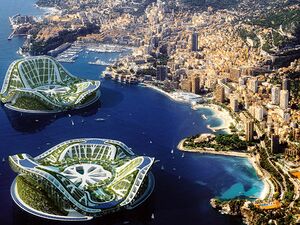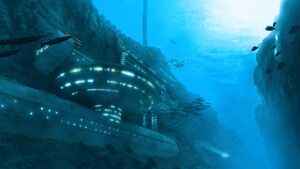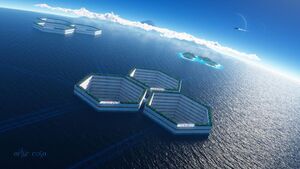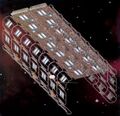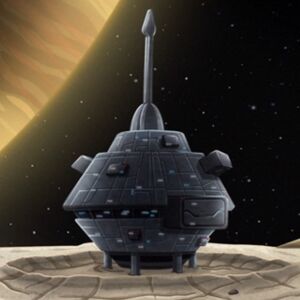Difference between pages "Brahms Station" and "Avalon Fleet Yards"
CrimsonTacit (talk | contribs) |
CrimsonTacit (talk | contribs) |
||
| Line 1: | Line 1: | ||
{{workinprogress}}{{Starbase | {{workinprogress}}{{Starbase | ||
| name = | | name = Avalon Fleet Yards | ||
| image = [[File: | | image = [[File:USS_Enterprise-E_in_drydock_2.png]] | ||
| registry = | | registry = SFY-007 | ||
| class = | | class = Fleet Yard | ||
| commission = | | commission = 2355 | ||
| decommission = | | decommission = | ||
| taskforce = | | taskforce = | ||
| quadrant = [[Alpha Quadrant]] | | quadrant = [[Alpha Quadrant]] | ||
| role = | | role = Starship Construction & Repair | ||
| affiliation = *[[United Federation of Planets]] | | affiliation = *[[United Federation of Planets]] | ||
*[[Starfleet]] | *[[Starfleet]] | ||
| sector = Grazer Sector | | sector = Grazer Sector | ||
| system = Avalon System | | system = Avalon System | ||
| co = Admiral | | co = Admiral TBD | ||
| crew =*100,000 Starfleet | | crew =*100,000 Starfleet | ||
*75,000 Civilian | *75,000 Civilian | ||
| dedication = | | dedication = | ||
}}''' | }}'''Avalon Fleet Yards''' is a major Federation shipyard serving as the primary starship construction and maintenance facility for Starfleet's Fourth, Seventh, and Ninth Fleets. Located in the Grazer Sector within the trailing rimward section of the Alpha Quadrant, this base has long served as a production facility for starships of all kinds and has played an important role in the development and testing of many new classes. While starbases, such as Starbase Bravo provide day-to-day support for the Fourth Fleet, this shipyard handles the most difficult and time-consuming refits that can't be accomplished at a standard starbase. | ||
== | == History == | ||
The Avalon System was first surveyed in the 2290s. It was immediately recognized as an important energy production site, as it was home to both substantial dilithium and deuterium reserves. Facilities were constructed on Avalon II and its largest moon, Avalon Prime, in the years that followed to obtain these valuable substances. Heavy ice mining stations were constructed on Avalon III in the early 2300s. In the 2350s, Starfleet decided to expand the facility into a fleet yard to expand production capabilities in the rimward region of Federation space. An ''Anchorage''-class station was towed into position above Avalon II to coordinate the efforts of several dry dock facilities. | |||
In the late 2360s, the facility was expanded significantly to bolster the fleet following Wolf 359. In the 2370s, it was an important facility for the fleet's Dominion War efforts because of its position far behind Federation lines. It was during the 2370s that it became the primary fleet yard for the Fourth Fleet, a role that it retains in the 25th century. By the late 2370s, the original ''Anchorage''-class station was found to be too small for the volume of work faced by the fleet yards, so a new ''Probert''-class spacedock was built there. | |||
As of the 25th century, Avalon Fleet Yards is one of the largest starship production facilities in the Federation, and its importance has only increased following the destruction of Utopia Planitia in 2385. This installation now also supports the Seventh and Ninth Fleets. | |||
== Organization == | |||
Avalon Fleet Yards is a major command, responsible to Starfleet Engineering. With a total crew of over 100,000, Avalon is under the command of an admiral, who is assisted by less senior flag officer in charge of the shipyard's planetary, orbital, and mobile assets. The fleet yard primarily serves the Fourth, Seventh, and Ninth Fleets, and so the flag officer in command is in continual contact with the staffs of these three fleets. The Fourth Fleet provides security for the yard and controls the majority of its research & development programs, through the [[Avalon Research & Design Group|Avalon Group]]. | |||
== | === Avalon Research & Design Group === | ||
Avalon Fleet Yards | The [[Avalon Research & Design Group|Avalon Group]] of the Fourth Fleet Research & Design Bureau is housed at Avalon Fleet Yards. This group consists of dozens of institutes and projects spread across Avalon's many stations and its shore facilities. | ||
== Facilities == | |||
Avalon Fleet Yards is a massive installation with orbital and planet-side facilities. The yard's headquarters and the living quarters for many of its staff are located on Avalon II. The primary orbital facility is Brahms Station, a [[Probert Class|''Probert''-class spacedock]] orbiting between Avalon II and its largest moon, which has been mined extensively for dilithium and has nearly been hollowed out to provide additional space for fabrication and assembly facilities. There are dozens of dry docks around the spacedock and the moon. Additional orbital stations provide research and design, storage, and additional accommodations. | |||
=== Avalon II Facilities === | |||
Avalon II is an ocean world that has large quantities of heavy water. This substance makes the planet an excellent natural fuel source for starships. Floating deuterium refineries bob on the waves around one of the planet's only land masses, which also plays host to the fleet yard's shore facilities. Additional research stations are spread around the planet, both on and under the ocean's surface. There are several dry docks built in shallow areas that allow for the construction and repair of smaller starships capable of planetary landings. | |||
==== Sato City ==== | |||
[[File:SatoCity.jpg|alt=Sato City to the right, with newer floating facilities to the left.|thumb|Sato City to the right, with newer floating facilities to the left.]] | |||
Named for early Earth Starfleet explorer Hoshi Sato, Sato City has a permanent population of 20,000, with housing space for up to 20,000 more transient personnel. Small by Federation standards, this town has all of the comforts one would expect from a Federation colony. Most of the fleet yards' long-term staff live here and take shuttles or transporters into orbit. The landmass here is narrow and rocky, snaking and branching in a way that creates deep fjords between its many peninsulas. This means that most of the structures are narrow and tall, including most of the housing—mainly single-family townhouses. There are a few parks created in the larger flatter areas, and in recent decades floating platforms have been placed in the small coves to provide additional space. The fleet yard's administrative headquarters are in the center of Sato City, which is home to the admiral—though in practice, the admiral is in space more than they are on the ground. | |||
Sato City is also home to the Avalon branch of the Fourth Fleet Academy, which specializes in providing advanced training to third and fourth-year cadets in engineering. Approximately two-hundred students attend this program at any given time. They live and study in an interconnected dormitory and classroom complex overlooking the ocean. | |||
'''In-Play''' | |||
* On a tiny landmass in an otherwise never-ending ocean, Sato City resembles a mediterranean city like Palermo or Malta, with narrow, winding streets. By and large, it is a sleepy residential community, and an excellent place to raise a family. Many of the fleet yards crew have spent a decade or more living and working here, and so the community bonds are tight-knit. | |||
* You're unlikely to find palatable seafood here, as the biology on Avalon II is incompatible with most Federation species—other than Bolians, who consider this to be a culinary mecca. | |||
* For those cadets interested in Engineering, this is a coveted place to finish one's third and fourth years, especially given that one will gain the opportunity to serve one's midshipman cruise aboard the technology testbed [[Avalon Fleet Yards#USS Edwin H. Armstrong|USS ''Edwin H. Armstrong'']]''.'' It's easy to imagine a cruise like this being significantly more exciting than some others—if your idea of excitement is matching wits with an experimental piece of prototype technology! | |||
==== Deuterium Refineries & Research Stations ==== | |||
[[File:AvalonUnderwaterScience.jpg|alt=A Starfleet Marine Biology station built into the side of an underwater cliff to study pelagic life.|thumb|A Starfleet Marine Biology station built into the side of an underwater cliff to study pelagic life.]] | |||
The planet's deuterium refineries are largely automated. Clusters of these refineries are connected by flexible but tough piping to bunkers on the ocean's floor. It takes many months for the refineries to fill up each bunker, at which point tankers transfer the deuterium to orbital storage facilities. Smaller quantities of deuterium can also placed in cargo shuttles fitted out as tankers from small landing pads at each refinery, and this is often done when ships in orbit need a top-off. Deuterium is incredibly flammable, and so visitors to these refineries must observe strict fire safety protocols. | |||
There are multiple research stations on Avalon II, studying the planet's unique ecosphere, mineral deposits, and other areas of interest. The higher density of heavy water means that those on the ocean floor must be specially reinforced. These facilities are run by a mix of Starfleet Science offices and civilian Federation agencies. Typically, the scientists on these stations commute between Sato City and their outlying research posts, but some of the most remote stations have their own accommodations. | |||
'''In-Play''' | |||
* There are dozens of small facilities spread throughout Avalon II, which means that there are dozens of different settings for stories about underwater science, deuterium refining, and other activities that would make for great interludes from your epic starship stories. | |||
* Every aspect of biological, mineralogical, and planetary sciences would be represented on these outposts. | |||
{{Clear}} | |||
==== Ocean Dry Docks ==== | |||
[[File:AvalonOceanDrydock.jpg|alt=These sunken drydocks reclaim a small portion of the planet's surface for use in construction projects.|thumb|These sunken dry docks reclaim a small portion of the planet's surface for use in construction projects.]] | |||
Made out of concrete reinforced with titanium, several hexagonal caisson structures were built in the shallows near to Sato City. These facilities provide stable, flat surfaces for maintaining and constructing small starships. Ships with landing legs can land directly on the floor of the drydock, while ships without this capability can be supported in mechanical cradles that deploy from the side walls. Capable of being sealed with forcefields, these large structures can also be used for general storage when necessary. Starfleet has considered creating facilities large enough to construct explorer-type starships, but the resource outlay required to do so would be significant, as the walls of the caissons need to be thicker and thicker as they get wider to compensate for the pressure of the water. | |||
'''In-Play''' | |||
* A caisson is a tube that displaces water to allow the floor of a body of water to be exposed to the air. These dry docks are large caissons featuring landing areas for small starships. The view here is slightly more interesting, or at least a little mundane, compared to that of the dry docks in orbit. | |||
* Ships that could make use of these dry docks would be of the ''Luna'' class or smaller. | |||
{{Clear}} | |||
=== Orbital Facilities === | |||
In addition to planetary facilities, Avalon Fleet Yards has a substantial orbital presence, anchored by a new ''Probert''-class station constructed in the 2380s, in addition to free-floating orbital dry docks and smaller subsidiary stations. | |||
== | ==== Brahms Station ==== | ||
Brahms Station | {{For|article=[[Brahms Station]]}}[[File:ProbertClass.jpg|alt=Capable of hosting ships of all sizes, Brahms Station is the primary facility for Avalon Fleet Yards.|thumb|Capable of hosting ships of all sizes, Brahms Station is the primary facility for Avalon Fleet Yards.]] | ||
The centerpiece of Avalon Fleet Yards is Brahms Station, a ''Probert''-class spacedock built in the 2380s to replace the [[Anchorage Class|''Anchorage''-class station]] that had originally been located there. Named for Dr. Leah Brahms, Brahms Station is capable of producing and maintaining starships of all classes and is the primary orbital habitat for personnel who do not live on Avalon II. In practice, this station most often builds frigate and cruiser-sized starships, while larger explorers are built and maintained at dedicated dry docks. It is also where visiting starships in need of only minor maintenance are serviced, to keep the dry docks free for more intensive construction tasks. It is also the primary defensive facility for the Avalon System, using its own substantial arsenal as well as a network of defense platforms to keep the fleet yard safe. The station itself is commanded by a Starfleet commodore or fleet captain in charge of all of the orbital facilities, who reports to the admiral in command of the fleet yards. | |||
'''In-Play''' | |||
* Brahms Station is identical to the Spacedock seen in Season 3 of ''Star Trek: Picard''. It is a large, modern station capable of giving even the largest ships their clearing space door moments. | |||
* This station is where your ship would dock if it needs minor maintenance, refueling, or personnel/cargo transfers. It's not where you'd go if you were missing a nacelle or two, as you'd want one of the dedicated dry dock facilities set aside for long-term repairs. | |||
* You can expect this station to have all of the modern conveniences that Starbase Bravo would. | |||
{{Clear}} | |||
=== | ==== Orbital Dry Docks ==== | ||
As with all Starfleet fleet yards, Avalon has many stand-alone dry dock facilities. These support frameworks provide a starship with power and life support while it is being constructed or repaired. They are generally used when a ship needs substantial work done, such as replacing its warp engines or other tasks which must be done with substantial clearance around the ship for maintenance vessels to maneuver. Most of these facilities can only handle a single starship at a time, but the larger ones are sometimes used to service more than one smaller ship, especially when the work being conducted is not intensive. <gallery> | |||
File:ESMDrydock.jpg | |||
File:Class9Drydock.jpg | |||
File:Class8Drydock.jpg | |||
File:Drydock.jpg | |||
</gallery>{{Clear}} | |||
==== Subsidiary Stations ==== | |||
File: | In addition to Brahms Station, there are a number of smaller stations at Avalon that provide additional engineering support capabilities, storage, and research and development facilities, especially for projects that are too volatile to be conducted on the main station. Depending on their size, they are each commanded by a commander or captain who reports to the commodore on Brahms Station. As of 2401, this group of stations includes 3 [[Presidium Class|''Presidium''-class facilities]], 1 [[Jupiter Class|''Jupiter''-class facility]], and the Yard's original [[Anchorage Class|''Anchorage''-class station]].<gallery> | ||
File:Presidioclass.jpg | |||
File:Jupiterstation.jpg | |||
File: | File:Regulusclass.png | ||
File: | |||
</gallery> | </gallery> | ||
=== | === Avalon Prime Facilities === | ||
[[File:RegulaOnMoon.jpg|alt=This station controls the mostly-automated facilities on Avalon Prime.|thumb|This station controls the mostly-automated facilities on Avalon Prime.]] | |||
Avalon Prime, formally Avalon IIB, is the largest of Avalon II's three moons, and the only one large enough to achieve a roughly spherical shape. This moon is home to dilithium deposits and was mined extensively throughout the 24th century to the point where these have largely been reduced to just traces. Much of the moon has been excavated and is now home to large scale power generators, fabricators, and storage facilities. Some of these storage bays are large enough to hold mothballed starships, even, and the planetoid now relies on powerful structural integrity field generators to remain intact. The majority of the equipment on Avalon Prime is automated, though there is substantial shuttle traffic in and out to move goods between the moon and the various starship construction projects around the system. Avalon Prime is just outside of transporter range from Brahms Station. These facilities are all controlled by a control center in a ''Regula''-type station body on the moon's equator under the command of the yard's orbital commodore. | |||
{{Clear}} | |||
== Mobile Assets == | |||
In addition to the many space stations, Avalon Fleet Yards is supported by a significant number of shuttles, runabouts, and starships. These assets, collectively Task Group Avalon, support the Yards' construction and maintenance mission and provide security. This group is under the command of a fleet captain or commodore, and is divided into three squadrons commanded by captains or fleet captains. | |||
The | === USS ''Edwin H. Armstrong'' === | ||
The USS ''Edwin H. Armstrong'' is the only remaining ''Ambassador''-class starship in Starfleet mainline service. Saved from the mothball yards or disarmament for Auxiliary Service by Admiral [NAME], the ''Armstrong'' is the ex-USS ''Adelphi'' renamed for the first recipient of the Medal of Honor from the Institute of Electrical and Electronics Engineers for his invention of Frequency Modulation and the superheterodyne receiver system. The ''Armstrong'' serves as an experimental testbed vessel for new starship technologies and as a training ship for the Avalon branch of Starfleet Academy. This vessel is also the flagship of the Yards' commanding officer. | |||
=== Avalon Security Squadron === | |||
At any given time, there are at least four ''Inquiry''-class heavy cruisers and an equal number of frigates or escorts on patrol in the Avalon System. Typically, this is an assignment that these ships perform for a few weeks or months at a time after having rotated off of a deep space assignment. In addition, there is a full division of starfighters, consisting of 48 [[Starfighters#Valkyrie-class fighter|''Valkyrie''-class craft]]. The starships for this squadron are drawn exclusively from the Fourth Fleet, and are loaned from their assignments within task forces. | |||
'''In-Play''' | |||
* A temporary assignment away from your task force to Avalon Security Squadron to stand guard over the fleet yard would be a good premise for an interlude mission that is not set around shore leave or other in-universe downtime. It would be an excellent opportunity to focus on character-character interactions, rather than a ton of action, as this would be a very quiet assignment for any ship. Indeed, it might be a punishment to some captains, or a reward to others, depending on their view of excitement. | |||
The | === Avalon Utility Squadron === | ||
The Avalon Utility Squadron consists of a dozen or so tugs, transports, and engineering support vessels, including one ''California''-class utility cruiser. The vessels in this squadron perform countless tasks across the yards, ranging from moving cargo containers and towing inactive starships, to refueling, to performing repairs on stations and equipment in the system. A half-dozen ''Aerie''-class vessels in short-haul passenger configuration provide regular service between all of the stations and the two colonies on a daily schedule. | |||
=== | === Avalon Trial Squadron === | ||
Avalon | The Avalon Trial Squadron consists of any starships that are undergoing shakedown cruises or space trials under the auspices of Avalon Fleet Yards. This is always a temporary posting for the ships in question, and the purpose of this squadron is to coordinate their operations to ensure that each ship undergoing its trials is adequately supported. | ||
== Avalon Fleet Yards In-Play == | |||
* Avalon Fleet Yards is a Fleet Asset, meaning that it is available for all members to use in their fictions as a setting. While Starbase Bravo and each task force headquarters are impressive installations, AFY is ideal for stories involving starship construction or repair. It also has its own Academy branch for cadet stories. There are numerous stations in the Avalon system that are also excellent places for self-contained stories or character histories. | |||
* Many Fourth Fleet starships were built at Avalon, making it a good choice for your dedication plaque. | |||
* Since the Fourth Fleet provides security for Avalon, having your ship or character stationed here for a time during its history could be a good way of filling in a historical gap. | |||
* While AFY serves the Fourth Fleet, other fleets also use it, so there are opportunities for interesting rivalries here. | |||
[[Category:Starfleet Facilities]] | |||
Revision as of 20:24, 8 July 2023

| |
| Avalon Fleet Yards | |
| Information | |
| Registry | SFY-007 |
| Class |
Fleet Yard |
| Affiliation | |
| Location | |
| System | Avalon System |
| Sector | Grazer Sector |
| Quadrant | Alpha Quadrant |
| Assignment | |
| Role |
Starship Construction & Repair |
| Personnel | |
| Commanding Officer | Admiral TBD |
| Station Populations |
|
| Template:Starbase | |
Avalon Fleet Yards is a major Federation shipyard serving as the primary starship construction and maintenance facility for Starfleet's Fourth, Seventh, and Ninth Fleets. Located in the Grazer Sector within the trailing rimward section of the Alpha Quadrant, this base has long served as a production facility for starships of all kinds and has played an important role in the development and testing of many new classes. While starbases, such as Starbase Bravo provide day-to-day support for the Fourth Fleet, this shipyard handles the most difficult and time-consuming refits that can't be accomplished at a standard starbase.
History
The Avalon System was first surveyed in the 2290s. It was immediately recognized as an important energy production site, as it was home to both substantial dilithium and deuterium reserves. Facilities were constructed on Avalon II and its largest moon, Avalon Prime, in the years that followed to obtain these valuable substances. Heavy ice mining stations were constructed on Avalon III in the early 2300s. In the 2350s, Starfleet decided to expand the facility into a fleet yard to expand production capabilities in the rimward region of Federation space. An Anchorage-class station was towed into position above Avalon II to coordinate the efforts of several dry dock facilities.
In the late 2360s, the facility was expanded significantly to bolster the fleet following Wolf 359. In the 2370s, it was an important facility for the fleet's Dominion War efforts because of its position far behind Federation lines. It was during the 2370s that it became the primary fleet yard for the Fourth Fleet, a role that it retains in the 25th century. By the late 2370s, the original Anchorage-class station was found to be too small for the volume of work faced by the fleet yards, so a new Probert-class spacedock was built there.
As of the 25th century, Avalon Fleet Yards is one of the largest starship production facilities in the Federation, and its importance has only increased following the destruction of Utopia Planitia in 2385. This installation now also supports the Seventh and Ninth Fleets.
Organization
Avalon Fleet Yards is a major command, responsible to Starfleet Engineering. With a total crew of over 100,000, Avalon is under the command of an admiral, who is assisted by less senior flag officer in charge of the shipyard's planetary, orbital, and mobile assets. The fleet yard primarily serves the Fourth, Seventh, and Ninth Fleets, and so the flag officer in command is in continual contact with the staffs of these three fleets. The Fourth Fleet provides security for the yard and controls the majority of its research & development programs, through the Avalon Group.
Avalon Research & Design Group
The Avalon Group of the Fourth Fleet Research & Design Bureau is housed at Avalon Fleet Yards. This group consists of dozens of institutes and projects spread across Avalon's many stations and its shore facilities.
Facilities
Avalon Fleet Yards is a massive installation with orbital and planet-side facilities. The yard's headquarters and the living quarters for many of its staff are located on Avalon II. The primary orbital facility is Brahms Station, a Probert-class spacedock orbiting between Avalon II and its largest moon, which has been mined extensively for dilithium and has nearly been hollowed out to provide additional space for fabrication and assembly facilities. There are dozens of dry docks around the spacedock and the moon. Additional orbital stations provide research and design, storage, and additional accommodations.
Avalon II Facilities
Avalon II is an ocean world that has large quantities of heavy water. This substance makes the planet an excellent natural fuel source for starships. Floating deuterium refineries bob on the waves around one of the planet's only land masses, which also plays host to the fleet yard's shore facilities. Additional research stations are spread around the planet, both on and under the ocean's surface. There are several dry docks built in shallow areas that allow for the construction and repair of smaller starships capable of planetary landings.
Sato City
Named for early Earth Starfleet explorer Hoshi Sato, Sato City has a permanent population of 20,000, with housing space for up to 20,000 more transient personnel. Small by Federation standards, this town has all of the comforts one would expect from a Federation colony. Most of the fleet yards' long-term staff live here and take shuttles or transporters into orbit. The landmass here is narrow and rocky, snaking and branching in a way that creates deep fjords between its many peninsulas. This means that most of the structures are narrow and tall, including most of the housing—mainly single-family townhouses. There are a few parks created in the larger flatter areas, and in recent decades floating platforms have been placed in the small coves to provide additional space. The fleet yard's administrative headquarters are in the center of Sato City, which is home to the admiral—though in practice, the admiral is in space more than they are on the ground.
Sato City is also home to the Avalon branch of the Fourth Fleet Academy, which specializes in providing advanced training to third and fourth-year cadets in engineering. Approximately two-hundred students attend this program at any given time. They live and study in an interconnected dormitory and classroom complex overlooking the ocean.
In-Play
- On a tiny landmass in an otherwise never-ending ocean, Sato City resembles a mediterranean city like Palermo or Malta, with narrow, winding streets. By and large, it is a sleepy residential community, and an excellent place to raise a family. Many of the fleet yards crew have spent a decade or more living and working here, and so the community bonds are tight-knit.
- You're unlikely to find palatable seafood here, as the biology on Avalon II is incompatible with most Federation species—other than Bolians, who consider this to be a culinary mecca.
- For those cadets interested in Engineering, this is a coveted place to finish one's third and fourth years, especially given that one will gain the opportunity to serve one's midshipman cruise aboard the technology testbed USS Edwin H. Armstrong. It's easy to imagine a cruise like this being significantly more exciting than some others—if your idea of excitement is matching wits with an experimental piece of prototype technology!
Deuterium Refineries & Research Stations
The planet's deuterium refineries are largely automated. Clusters of these refineries are connected by flexible but tough piping to bunkers on the ocean's floor. It takes many months for the refineries to fill up each bunker, at which point tankers transfer the deuterium to orbital storage facilities. Smaller quantities of deuterium can also placed in cargo shuttles fitted out as tankers from small landing pads at each refinery, and this is often done when ships in orbit need a top-off. Deuterium is incredibly flammable, and so visitors to these refineries must observe strict fire safety protocols.
There are multiple research stations on Avalon II, studying the planet's unique ecosphere, mineral deposits, and other areas of interest. The higher density of heavy water means that those on the ocean floor must be specially reinforced. These facilities are run by a mix of Starfleet Science offices and civilian Federation agencies. Typically, the scientists on these stations commute between Sato City and their outlying research posts, but some of the most remote stations have their own accommodations.
In-Play
- There are dozens of small facilities spread throughout Avalon II, which means that there are dozens of different settings for stories about underwater science, deuterium refining, and other activities that would make for great interludes from your epic starship stories.
- Every aspect of biological, mineralogical, and planetary sciences would be represented on these outposts.
Ocean Dry Docks
Made out of concrete reinforced with titanium, several hexagonal caisson structures were built in the shallows near to Sato City. These facilities provide stable, flat surfaces for maintaining and constructing small starships. Ships with landing legs can land directly on the floor of the drydock, while ships without this capability can be supported in mechanical cradles that deploy from the side walls. Capable of being sealed with forcefields, these large structures can also be used for general storage when necessary. Starfleet has considered creating facilities large enough to construct explorer-type starships, but the resource outlay required to do so would be significant, as the walls of the caissons need to be thicker and thicker as they get wider to compensate for the pressure of the water.
In-Play
- A caisson is a tube that displaces water to allow the floor of a body of water to be exposed to the air. These dry docks are large caissons featuring landing areas for small starships. The view here is slightly more interesting, or at least a little mundane, compared to that of the dry docks in orbit.
- Ships that could make use of these dry docks would be of the Luna class or smaller.
Orbital Facilities
In addition to planetary facilities, Avalon Fleet Yards has a substantial orbital presence, anchored by a new Probert-class station constructed in the 2380s, in addition to free-floating orbital dry docks and smaller subsidiary stations.
Brahms Station
The centerpiece of Avalon Fleet Yards is Brahms Station, a Probert-class spacedock built in the 2380s to replace the Anchorage-class station that had originally been located there. Named for Dr. Leah Brahms, Brahms Station is capable of producing and maintaining starships of all classes and is the primary orbital habitat for personnel who do not live on Avalon II. In practice, this station most often builds frigate and cruiser-sized starships, while larger explorers are built and maintained at dedicated dry docks. It is also where visiting starships in need of only minor maintenance are serviced, to keep the dry docks free for more intensive construction tasks. It is also the primary defensive facility for the Avalon System, using its own substantial arsenal as well as a network of defense platforms to keep the fleet yard safe. The station itself is commanded by a Starfleet commodore or fleet captain in charge of all of the orbital facilities, who reports to the admiral in command of the fleet yards.
In-Play
- Brahms Station is identical to the Spacedock seen in Season 3 of Star Trek: Picard. It is a large, modern station capable of giving even the largest ships their clearing space door moments.
- This station is where your ship would dock if it needs minor maintenance, refueling, or personnel/cargo transfers. It's not where you'd go if you were missing a nacelle or two, as you'd want one of the dedicated dry dock facilities set aside for long-term repairs.
- You can expect this station to have all of the modern conveniences that Starbase Bravo would.
Orbital Dry Docks
As with all Starfleet fleet yards, Avalon has many stand-alone dry dock facilities. These support frameworks provide a starship with power and life support while it is being constructed or repaired. They are generally used when a ship needs substantial work done, such as replacing its warp engines or other tasks which must be done with substantial clearance around the ship for maintenance vessels to maneuver. Most of these facilities can only handle a single starship at a time, but the larger ones are sometimes used to service more than one smaller ship, especially when the work being conducted is not intensive.
Subsidiary Stations
In addition to Brahms Station, there are a number of smaller stations at Avalon that provide additional engineering support capabilities, storage, and research and development facilities, especially for projects that are too volatile to be conducted on the main station. Depending on their size, they are each commanded by a commander or captain who reports to the commodore on Brahms Station. As of 2401, this group of stations includes 3 Presidium-class facilities, 1 Jupiter-class facility, and the Yard's original Anchorage-class station.
Avalon Prime Facilities
Avalon Prime, formally Avalon IIB, is the largest of Avalon II's three moons, and the only one large enough to achieve a roughly spherical shape. This moon is home to dilithium deposits and was mined extensively throughout the 24th century to the point where these have largely been reduced to just traces. Much of the moon has been excavated and is now home to large scale power generators, fabricators, and storage facilities. Some of these storage bays are large enough to hold mothballed starships, even, and the planetoid now relies on powerful structural integrity field generators to remain intact. The majority of the equipment on Avalon Prime is automated, though there is substantial shuttle traffic in and out to move goods between the moon and the various starship construction projects around the system. Avalon Prime is just outside of transporter range from Brahms Station. These facilities are all controlled by a control center in a Regula-type station body on the moon's equator under the command of the yard's orbital commodore.
Mobile Assets
In addition to the many space stations, Avalon Fleet Yards is supported by a significant number of shuttles, runabouts, and starships. These assets, collectively Task Group Avalon, support the Yards' construction and maintenance mission and provide security. This group is under the command of a fleet captain or commodore, and is divided into three squadrons commanded by captains or fleet captains.
USS Edwin H. Armstrong
The USS Edwin H. Armstrong is the only remaining Ambassador-class starship in Starfleet mainline service. Saved from the mothball yards or disarmament for Auxiliary Service by Admiral [NAME], the Armstrong is the ex-USS Adelphi renamed for the first recipient of the Medal of Honor from the Institute of Electrical and Electronics Engineers for his invention of Frequency Modulation and the superheterodyne receiver system. The Armstrong serves as an experimental testbed vessel for new starship technologies and as a training ship for the Avalon branch of Starfleet Academy. This vessel is also the flagship of the Yards' commanding officer.
Avalon Security Squadron
At any given time, there are at least four Inquiry-class heavy cruisers and an equal number of frigates or escorts on patrol in the Avalon System. Typically, this is an assignment that these ships perform for a few weeks or months at a time after having rotated off of a deep space assignment. In addition, there is a full division of starfighters, consisting of 48 Valkyrie-class craft. The starships for this squadron are drawn exclusively from the Fourth Fleet, and are loaned from their assignments within task forces.
In-Play
- A temporary assignment away from your task force to Avalon Security Squadron to stand guard over the fleet yard would be a good premise for an interlude mission that is not set around shore leave or other in-universe downtime. It would be an excellent opportunity to focus on character-character interactions, rather than a ton of action, as this would be a very quiet assignment for any ship. Indeed, it might be a punishment to some captains, or a reward to others, depending on their view of excitement.
Avalon Utility Squadron
The Avalon Utility Squadron consists of a dozen or so tugs, transports, and engineering support vessels, including one California-class utility cruiser. The vessels in this squadron perform countless tasks across the yards, ranging from moving cargo containers and towing inactive starships, to refueling, to performing repairs on stations and equipment in the system. A half-dozen Aerie-class vessels in short-haul passenger configuration provide regular service between all of the stations and the two colonies on a daily schedule.
Avalon Trial Squadron
The Avalon Trial Squadron consists of any starships that are undergoing shakedown cruises or space trials under the auspices of Avalon Fleet Yards. This is always a temporary posting for the ships in question, and the purpose of this squadron is to coordinate their operations to ensure that each ship undergoing its trials is adequately supported.
Avalon Fleet Yards In-Play
- Avalon Fleet Yards is a Fleet Asset, meaning that it is available for all members to use in their fictions as a setting. While Starbase Bravo and each task force headquarters are impressive installations, AFY is ideal for stories involving starship construction or repair. It also has its own Academy branch for cadet stories. There are numerous stations in the Avalon system that are also excellent places for self-contained stories or character histories.
- Many Fourth Fleet starships were built at Avalon, making it a good choice for your dedication plaque.
- Since the Fourth Fleet provides security for Avalon, having your ship or character stationed here for a time during its history could be a good way of filling in a historical gap.
- While AFY serves the Fourth Fleet, other fleets also use it, so there are opportunities for interesting rivalries here.

